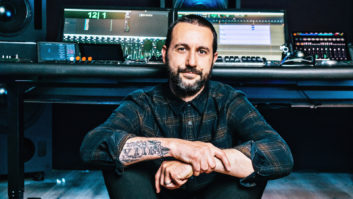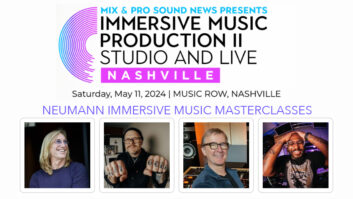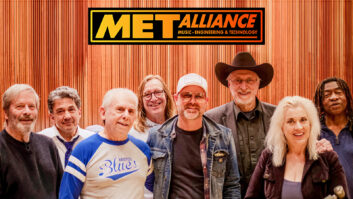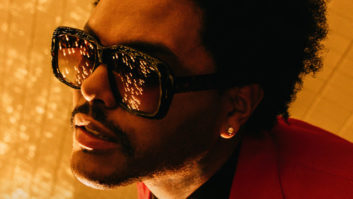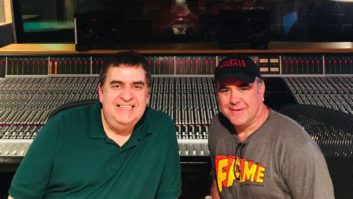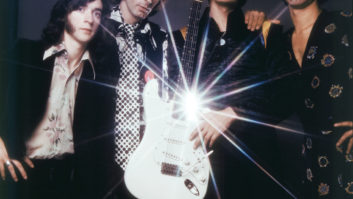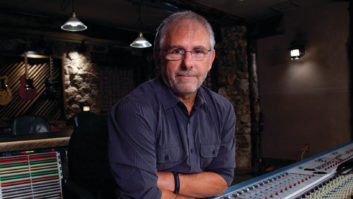Sometimes it seems as though HBO can do no wrong. The network’s ongoing original series, including The Sopranos, Sex and the City, Six Feet Under and Curb Your Enthusiasm, have earned nearly universal critical plaudits and excellent ratings. And, over the past few years, HBO has produced a number of fine films that have blurred the difference between theatrical features and made-for-cable movies.
The network’s latest triumph is also its most expensive and ambitious yet: The 10-part World War II epic miniseries Band of Brothers, which tells the true story of Easy Company — a unit of the 506th Parachute Infantry Regiment of the 101st Airborne Division — from their first training exercises in Georgia, to their adventures in Normandy during the D-Day invasion, through the Battle of the Bulge and the capture of Hitler’s infamous Eagle’s Nest headquarters.
Based on the book of the same name by eminent historian Stephen E. Ambrose, Band of Brothers is a sprawling yet surprisingly intimate tale that couldn’t possibly have been told in a conventional film; it needed the length a miniseries affords. With hundreds of speaking roles and dozens of locations required, it also took a significant budget — probably in the neighborhood of $120 million, the most expensive production for television ever. But with the names Steven Speilberg and Tom Hanks attached to the top of the film as executive producers, Band of Brothers had the built-in credibility and cachet to command such a large budget. Hanks had previously helmed the successful HBO miniseries about the U.S. space program, From the Earth to the Moon (which, at $65 million, was quite an undertaking, too), and Spielberg, of course, had already directed two of the greatest contemporary films about World War II — the holocaust drama Schindler’s List and his D-Day masterpiece Saving Private Ryan (the story of which was also drawn, in part, from the book Band of Brothers), which starred Hanks. Who’s going to say no to those two?
Shot mostly at Hatfield Studios near London, with audio post-production taking place at Shepperton Studios, Band of Brothers is the latest in a wave of HBO productions that is being broadcast in the Dolby Digital 5.1 surround format. “In my opinion, there aren’t any real differences between doing a surround mix for television and one for a feature film,” says re-recording mixer Mike Dowson, who has worked at Shepperton for the past 15 years on productions ranging from grand-scale films such as Full Metal Jacket, Elizabeth and Schindler’s List to smaller works such as Snatch and RKO 281, the HBO film about the war between Orson Welles and William Randolph Hearst over Citizen Kane, which earned Dowson, Mark Taylor and Clive Derbyshire an Emmy in 2000 for sound mixing. “Economies of scale and economies of production come into it because, quite often, TV productions don’t have the same kind of money as feature films do. However, on this particular project, HBO has spent a lot of money and time, and as far as I can tell, they’re very keen to promote 5.1 and high-definition in the home. So it was quite important for us to give them something really good, even if only 30 people in America are going to hear it the way it should be,” Dowson says with a laugh, referring to the paucity of people who have adequate surround setups in their homes.
The project was extremely challenging for the sound crew because of its length, its wide scope and the fact that nine of the 10 episodes had a different director. Though certainly Hanks and, to a lesser degree, Spielberg had a lot to do with the overall look and feel of the series, Dowson says that from his perspective, co-producer Tony To (pronounced toe; he was an executive producer on From the Earth to the Moon) was the principal architect of Band of Brothers: “When you have a series such as this, it’s very important to get one man’s vision of it, and that person has been Tony To. It’s essentially his baby, although obviously there are many, many other people involved in it. He’s the major creative force in it in terms of setting the style and the look and sound of the show.” To also directed an episode, as did Hanks.
Just as Saving Private Ryan used sound in bold and unusual ways, mixing a nearly documentary style with some exaggerated and almost hallucinatory sound moments, Band of Brothers dares to be different, as well: It features long stretches where the most prominent sounds are those of breathing or feet marching or distant gunfire, without music to color the emotion of the scenes. (Michael Kamen scored the series but, Dowson says, “There isn’t that much music for a show this long.”) “We used quite a bit of location sound — more than I would have predicted, actually,” Dowson notes, “but, of course, there’s also lots of ADR and lots of effects; Campbell Askew was the effects supervisor and he did a great job coming up with a nice variety of sounds and textures.” Shepperton engineer Mark Taylor was the effects mixer; he and Dowson often work as co-mixers. Together, they had to balance the dramatic and semi-documentary approaches to making the series.
Dowson says, “There’s an absolutely stunning sequence in Episode Two where the guys jump for the first time into Normandy behind the lines; it’s really something to behold — both the sound and the visuals are fantastic. They had a special screening at Normandy for some veterans — they actually built cinemas on the beach there — and after showing Episode Two, a number of vets came up and they were raving about the sound inside the planes, and the sound of the flak took them right back there; they thought it was very authentic. A lot of the camera shots are very personal, almost documentary-style, and to try to capture that, especially when we had scenes with a lot of ADR, and to try and get a rough and ready feel about it but still have control of everything was very difficult. So, at times, you’re trying to make it a bit rough, make it slightly difficult for people to hear certain things, but knowing that if you really do need to hear a line, you can. We spent a lot of time doing that. We’ve been careful of what Tony calls ‘the filmmaker’s hand’ — we’ve tried to keep it fairly real at times, but if it’s just begging for ‘Hollywood,’ then it gets that, too.”
What do you do to muddy a track? “I get the dialog editors to troll the tracks for any kind of shitty movement that you get, because sometimes that adds an authenticity — especially to ADR — that makes it slightly less clinical-sounding. The other major thing we did on this series is we predubbed the dialogs last, whereas it’s normal for people to predub dialog first. We knew there would be quite a lot of ADR, and we felt if we mixed backgrounds and Foley and hard effects first, then when we came to mix the dialogs, we knew what we had to do. We had to make the dialogs work their way through this noise. What happens is, if you mix it the other way around, you set down your dialogs and then you shape your effects around there, and you have to make a bit of a compromise if you’re trying to describe reality.”
Shepperton Studios is one of the oldest and most respected film and post facilities in England, with credits going back more than half a century and including such diverse titles as The Third Man, Oliver, Alien and 101 Dalmatians, among scores of others. But technologically, the studio has always been right up-to-date. The room in which Band of Brothers was mixed “is like a small cinema essentially,” Dowson says. “I mixed Snatch in this room, Elizabeth and various other projects. It’s got a wonderful Harrison MPC desk,” fully automated, with 136 inputs, 72 on faders and 64 on predubs, with 48 main output buses and 24 re-assign buses. Dowson is quite keen on the room’s JBL 4675A cinema speaker system — “a three-way system that uses XTA digital crossovers, which are very important because all the room correction is done in those crossovers and then it’s time-aligned, which across a speaker of that size — maybe six or seven feet high from the lowest bass end to the top — is crucial. There’s also about 13 and a half kilowatts of Crown amps in here.
“The thing I find when I’m mixing my release formats here is that the scale of everything is very important, so if I’m mixing something with a large picture image, as I’m looking at now — I’ve got a TV picture up on my screen, which is maybe 25 or 30 feet diagonal — it’s quite important that you listen to that with large speakers behind the screen in their correct positions. If I mix with a TV monitor — and we sometimes refer to a monitor — it’s important that we have speakers that are in the same scale as that and in similar positions. Although it’s true that the brain adapts itself to where it hears sound from — you can have a speaker 20 feet away from a monitor and eventually if you stare at the monitor enough, you’ll start to hear sound from the monitor. But the illusion is broken instantly as soon as you lose concentration. But you want the mix to translate well across the different sizes, so the scale of things is important. Monitor levels are also very important — that you keep a constant monitor level as something that you refer to every time.”
Dowson says, “This particular show has been almost entirely post-produced using Pro Tools. The film was cut using Avids so they could run EDLs and OMFs and what have you, so Pro Tools worked well for them. Effects editors use Pro Tools a lot, dialog people might use something else. [The production dialog was recorded on DAT with a Nagra backup.] But mostly it was Pro Tools all the way until it got to us, and then we would play off the tracks and mix them onto Akai DD8 systems. We have a whole stack of those and would then record the premixes. It’s a good, mature product and we’re not wanting much more from it. We get excellent support from Akai here. The major change for us with the system normally is when a new kind of drive comes out — like we’re just trying out 9.1-gig magneto-optical drives with them and that looks very promising to us.”
The series was shot both outdoors and on giant soundstages at the Hatfield Aerodrome, “which offered Band of Brothers an enormous piece of land on which they could build a fantastically huge set; it’s quite stunning. If you’ve seen any of the scenes that are in trees and in snow, that was a set inside. There was a lot of CGI work, which was frustrating for us at times, and we had to work around it, but it looks so impressive.”
Working in 5.1, part of the challenge for Dowson and Taylor was to make the outdoor scenes that were shot indoors sound like outdoors, and to put enough information in the rear speakers to make the mix interesting but not gimmicky or distracting. “We spread some stereo ambiences to make you feel like you’re outside or inside or whatever,” Dowson says. “We also used it for proper surround reverbs on dialog when we could, and with this subject matter, it’s been used for panning various things around — bombs fly over you, planes fly over you, debris flies over you when there’s a big explosion on the screen; so it’s a myriad of things rather than one particular thing.”
Because of his background in mixing films, Dowson sees the center channel in 5.1 as a vital element — “It gets used the same as left and right. It has dialog, effects, music. It’s a complete fallacy in the home that you can get away with small center speakers. Everyone thinks left and right are the main speakers. But the most important speaker in a Dolby surround or a 5.1 system is the center, and the vast majority of mixers working in film or television will tell you that if you take away the center speaker, you take away 80 or 90 percent of the mix. Most of the dialog comes from that center speaker, though it’s not really accurate to call it the ‘dialog speaker’ as some people do. I know that in the home, it’s sometimes sort of limited in terms of its position around a TV, but I think it’s important to have those voices similarly to the left and right — if you’re expecting smooth pans to work from left to center to right, you’ve got to have similar speakers to do that. And it’s got to be in the same plane, as well; at least the tweeters should be in the same plane.”
I asked Dowson if in mixing he used the subwoofer differently in this production, which is filled with bombs, rumbling engines and plenty of low-frequency information, than he did in a film such as Elizabeth. “I can’t say I consciously used the sub any differently for this,” he says, adding with a laugh, “You know, the front section of Elizabeth had that enormously loud sequence of people being burned at the stake — there was a lot of sub going on in that. I think sub-bass is there to enhance the kind of fears that people have. Low, bassy sounds are not really natural to humans, and I think that’s why they tend to make us feel the way they do, which is slightly scared or uneasy. Sub-bass as an effect channel is rarely put there to make something feel satisfying or reassuring. We don’t put everything to the sub, obviously, but if we feel it needs that extra octave and something can be slightly more impressive by doing it, then down there it goes. I don’t have any set ways of working. I treat each project differently, and they all have their own problems and their own quite unique solutions.”
Dowson is well aware that most people seeing Band of Brothers won’t be hearing his work in all of its glory, but he insists that it’s important to not make too many concessions to the reductive qualities of television sound. “I can’t worry about it; I want it to sound as good as I can make it,” he says. “I suppose it’s a quart into a pint pot at the end of the day, but essentially what we’ve done is treated it like 10 one-hour feature films. When you’ve got something of the scale that we have here, there’s only one way to mix it: You mix it as a full-scale feature film and then you downsize from there. That way, you get the detail in there. And the 5.1 mix will go and be broadcast pretty much as we mixed it. Then, in the home you’re deciding what kind of dynamic range you want with the show, really. From that 5.1 master, I’ll make a Lt-Rt master, which is in Dolby surround, and that, in turn, will be downsized into mono. Dolby E is being used on the high-definition video masters because most digital video machines used in the professional world have four digital tracks on them and, of course, we need at least six tracks to run this, so what they do is carry the stereo mix on tracks 1 and 2 on the digital machines, and 3 and 4 contain the Dolby E-encoded tracks, which is the 5.1 mix and maybe another 2-track on that as well.”
Besides its showings on HBO, Band of Brothers has been sold to the BBC for airing in Great Britain, and up the line it will, of course, make its way to both videotape and DVD. “Whether or not people have the proper systems at home to hear this as it’s intended,” Dowson says, “we’ve done our job and it’s there on the shelf, and it can demonstrate to people that there’s a valid upgrade to go from stereo or Dolby surround into 5.1 listening. And certainly there will be a DVD release and people can take advantage of that, even if they don’t have high-def in the home; they will still hear quite an extraordinary difference.”
